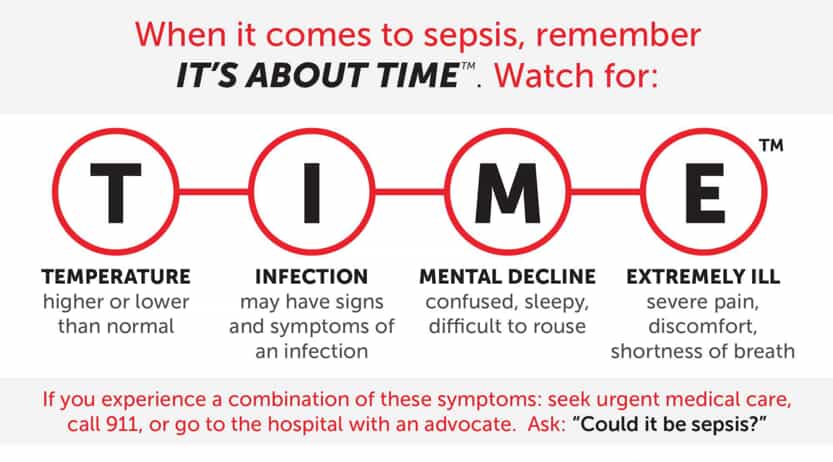Can you identify sepsis?
- Category: Blogs
- Posted On:

Can you identify sepsis?
Two of every three Americans say they know the word sepsis. But only 12 percent can identify its most common symptoms.
Sepsis is the body’s overwhelming and life-threatening response to infection that can lead to tissue damage, organ failure, and death. Like strokes or heart attacks, sepsis is a medical emergency that requires rapid diagnosis and treatment .
When it comes to identifying sepsis symptoms, remember “It’s About TIME.” This national initiative was created by the Sepsis Alliance, a charitable organization and the leading sepsis organization in the US. A person may have sepsis if he experiences a combination of the following symptoms:
T – Temperature, higher or lower than normal
I – Infection, may have signs or symptoms of infection
M – Mental decline, confused, sleepy, difficult to rouse
E – Extremely ill, severe pain, discomfort, shortness of breath
Sepsis progresses to severe sepsis when additional signs are present, including difficulty breathing, low or no urine output, and abnormal liver tests. Septic shock is most severe, and is diagnosed when blood pressure drops to dangerous levels.
Sepsis can be caused by any type of infection: bacterial, viral, fungal, or parasitic.
There is no cure for sepsis, but it can be avoided through good hygiene, avoiding people with infections, and vaccinations. Wounds can become infected and should be kept clean and monitored for signs of infection.
Early detection of sepsis provides the best chance for survival and recovery. If you suspect sepsis, call 9-1-1 immediately.
Below are sepsis facts from the Sepsis Alliance:
- Sepsis is the leading cause of death in US hospitals.
- 87% of sepsis cases originate in the community, not in the hospital.
- 80% of septic shock patients can be saved with rapid diagnosis and treatment.
- Viral sepsis is the most common complication in severe COVID-19.
- More than 1.7 million people in the US are diagnosed with sepsis each year.
- More US adults die from sepsis each year than stroke, prostate cancer, breast cancer, and opioid overdose combined.
- 35% of US adults have never heard of sepsis.



